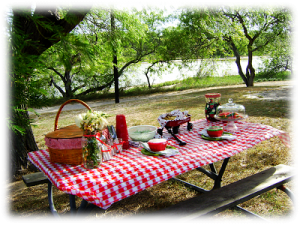by Dorothy C. Lee | Aug 28, 2016

Does lettuce turn brown and slimy in your refrigerator? Is that two-year-old frozen turkey still safe to eat? Should you dispose of that slightly moldy cheese? “When in doubt throw it out” is definitely a safe practice to follow. However, throwing food out is like throwing money away. A few simple guidelines for food storage can save dollars and time spent on shopping.
Dairy Do’s and Don’ts
- Buy milk in cardboard cartons or non-translucent containers. Translucent containers allow light to seep in, which can cause the milk to spoil. Store milk in a refrigerator that is set at 40° or lower. Don’t store milk in the door of the refrigerator. Items stored in the door of the refrigerator are more susceptible to warm air that enters the refrigerator each time the door is opened.
- Discard unused milk after the container has been opened for a week. Milk may be frozen for up to three weeks.
- Ice cream has a shelf life of two to four months as long as it is stored in a freezer that is set at zero degrees Fahrenheit.
- Yogurt should be used within seven to ten days of purchase.
- Butter may be refrigerated, tightly wrapped, for up to one month and be frozen for six months.
- Hard cheeses will keep for three or four weeks, tightly wrapped, in the refrigerator once they have been opened. Processed cheese spreads will keep for three to four weeks after opening.
- Purchase eggs before the sell by date. Store eggs in their original packaging on the middle or lower shelf of the refrigerator. Refrigerated uncooked eggs will keep for three to four weeks from the time they are purchased. Hard boiled eggs in the shell will keep for one week. Don’t freeze hard cooked whole eggs or egg whites. They will be tough and watery when defrosted. Raw egg whites can be frozen in ice cube trays.
Meat and Poultry
- Store meat and poultry in a refrigerator set at 35° to 40° Fahrenheit.
- Put packages of raw meat, poultry, or fish on a plate before refrigerating so their juices won’t drip on other foods. Raw juices often contain bacteria.
- Follow the “use by”, “keep refrigerated”, and “safe handling” information on the packaged meat label.
- Meat should be cooked or frozen within a few days of purchase.
- Use chicken by the sell-by date unless you plan on freezing it.
- Chicken and turkey may be frozen for nine months to a year.
- Cooked chicken or turkey should be eaten or frozen within three to four days of preparation.
Fruits and Vegetables
- Use refrigerated fruits and vegetables within a few days of purchase. Wash vegetables and fruits thoroughly right before eating or preparing.
- Fruits and vegetables stored at room temperature should be stored in perforated bags away from direct sunlight.
Canned Food Items
- Don’t purchase cans that are dented, bulging, or rusted.
- Store canned goods in a cool dry place.
- Rotate canned food items on a timely manner to establish a well-stocked pantry.
- Shelf life is determined by the acid content of the canned food.
To assure safe food storage, USDA recommends an appliance thermometer be installed in all refrigerators and freezer sections. Appliance thermometers are available at local supermarkets or discount stores. The refrigerator section should be set at 40°F and freezer section at 0°F.
Safe food storage is top priority to prevent foodborne illness. So remember, “Store It Right!”
For further information, contact:
Dorothy C. Lee, CFCS
UF/IFAS Extension Escambia County
3740 Stefani Road
Cantonment, FL 32533-7792
(850) 475-5230
dclee@ufl.edu
Reference: www.USDA.gov

by sbouie | Jul 17, 2016
 Picnics are a great opportunity for families to enjoy the great outdoors. It provides time to experience special bonding while enjoying the fresh air and delicious food. However, we should always be cautious of food borne illness.
Picnics are a great opportunity for families to enjoy the great outdoors. It provides time to experience special bonding while enjoying the fresh air and delicious food. However, we should always be cautious of food borne illness.
Let’s keep food and your family safe from the start! Whether the foods are from home, a store, or restaurant, follow the simple rules of keeping hot foods hot and cold foods cold. Remember that bacteria can grow fast at temperatures between 40°F and 140°F – the Danger Zone. Eat and promptly chill leftovers within two hours, and if the outside air temperature is above 90°F, do so within one hour.
If you plan to cook on site, make sure raw meats are packed well and are separated from ready-to-eat foods to prevent any cross-contamination. All perishable foods must be kept cold (40°F or below) in insulated boxes with enough ice, frozen gel packs, or other cold source, such as a container of frozen water. If possible, bring an appliance thermometer along to monitor the box temperature. When you grill the meat, make sure it is cooked to the right temperature. Also, bring enough potable water if none will be available at the site, and pack clean, wet, disposable cloths or moist towelettes and paper towels for cleaning hands and surfaces. Keep your tailgate party fun and bacteria-free for your family’s well-being!
Besides the food, plan your time. Plan some fun outdoor games that the entire family will enjoy. You may even plan a nature walk, name the cloud’s shape, or be creative and create your own activity. Whatever you plan, always involve the entire family. Every family member should be included.
This is the best time to say “no electronic devices.” This is time for the family to have face time without interruptions – time to talk to each other and grow closer. Picnic time translates “it’s family time” – eating outside in the fresh air and enjoying your family.
Reference: Food Safety and Tailgating, Amy Simonne. EDIS Publication #FAR8712
by Marjorie Moore | Jun 1, 2016
 Did you know that the majority of people grill on July 4th (82%), followed by Birthdays (72%), Labor Day (70%), Memorial Day (62%) and the Super Bowl (30%)? Grilling is an all-time favorite for many households and now that the weather is warming, more families are using their grills to prepare family meals.
Did you know that the majority of people grill on July 4th (82%), followed by Birthdays (72%), Labor Day (70%), Memorial Day (62%) and the Super Bowl (30%)? Grilling is an all-time favorite for many households and now that the weather is warming, more families are using their grills to prepare family meals.
Enjoy grilling this season but be sure to be safe to avoid accidents. According to the National Fire Protection Association between 2007-2011, gas grills were involved in an annual average of 7,200 home fires, while charcoal or other solid-fueled grills were responsible for an annual average of 1,400 home fires.
Whether you have a charcoal, gas or in-door grill, become the grill master in your house by carefully reading the manufacturer’s operating and maintenance instructions for your family’s grill. Follow these important tips to help you and your family use your grill safely.
- Regularly remove grease or fat buildup from the racks/grates to reduce chances of having a fire. Thoroughly clean your grill at least once a year so it will last longer.
- For charcoal grills, look at the new safety label on the charcoal bags. Charcoal is hard to ignite so people are often tempted to use ready-to-light charcoal or charcoal fluid. These products seem to make lighting charcoal easier, but they will introduce a lot of chemicals and sometimes leave a chemical taste on the food. Always, follow the manufacturer’s instructions and never use lighter fluid after the fire is started.
- Remember to only use your gas and charcoal grills outside.
- Place your gas grill at least 10 feet away from your house or any building. Never grill in the garage, breezeway, carport, porch, or under a surface that can catch fire.
- Keep a fire extinguisher accessible in the event of a fire.
- Always keep food safety in mind when grilling and use different dishes and utensils for raw meat and cooked meat. By putting cooked food on plates that held raw meat, you are cross-contaminating the food. Any bacteria present in the raw meat could be reintroduced to the cooked food.
- Cold food should be kept cold until ready to grill – never leave raw meat, poultry, or any perishable food out at room temperature for more than two hours.
- Don’t forget to use a thermometer, especially when cooking meat, poultry and fish. Raw meat can contain harmful bacteria and other pathogens, which can cause food poisoning if ingested. A meat thermometer is an especially important tool and will help guard against food poisoning. The color of meat and poultry is not a good indicator of safety.
For more information, check out our grilling factsheet. http://bay.ifas.ufl.edu/fnc/files/2011/09/Grilling-safety.pdf

by Angela Hinkle | May 19, 2016
 “Milk and milk products provide a wealth of nutrition benefits. But raw milk can harbor dangerous microorganisms that can pose serious health risks to you and your family. According to an analysis by the Centers for Disease Control and Prevention (CDC), between 1993 and 2006, more than 1,500 people in the United States became sick from drinking raw milk or eating cheese made from raw milk. In addition, CDC reported that unpasteurized milk is 150 times more likely to cause foodborne illness and results in 13 times more hospitalizations than illnesses involving pasteurized dairy products.”
“Milk and milk products provide a wealth of nutrition benefits. But raw milk can harbor dangerous microorganisms that can pose serious health risks to you and your family. According to an analysis by the Centers for Disease Control and Prevention (CDC), between 1993 and 2006, more than 1,500 people in the United States became sick from drinking raw milk or eating cheese made from raw milk. In addition, CDC reported that unpasteurized milk is 150 times more likely to cause foodborne illness and results in 13 times more hospitalizations than illnesses involving pasteurized dairy products.”
This is an excerpt from the U.S. Food and Drug Administration Protecting and Promoting Your Health website http://www.fda.gov/Food/ResourcesForYou/Consumers/ucm079516.htm. By reading the information and watching the video on this site, you can better understand the dangers of raw milk and how it can affect your family.
Milk is good for you and it tastes great. Just remember to drink it responsibly and safely.

by jbreslawski | Mar 11, 2016
 It seems that everywhere you look, an egg hunt is being advertised, egg dye kits are on every corner in the store, and the Internet is a-buzz with cool decorating ideas. Keep in mind this season that this fun family activity could turn rotten if you forget food safety.
It seems that everywhere you look, an egg hunt is being advertised, egg dye kits are on every corner in the store, and the Internet is a-buzz with cool decorating ideas. Keep in mind this season that this fun family activity could turn rotten if you forget food safety.
Outbreaks of foodborne illness, especially salmonella, have been associated with the improper preparation and storage of eggs. Salmonella is not something you want to remember when you think back to memories of decorating and hunting eggs in the spring.
Common symptoms of salmonella include nausea, vomiting, abdominal cramps, diarrhea, fever, and headache. Children are one population most susceptible to foodborne illness.
There is no reason to worry about potential food safety hazards associated with your holiday eggs as long as you remember to follow these guidelines:
- Clean and sanitize your hands, preparation area, and utensils before, during, and after the cooking process.
- Use eggs that are clean and free of cracks and leaks.
- Cook eggs completely – no rushing or short cuts. If you don’t have the time, pick another day to do it.
- Use only food-grade dyes; these include food coloring and dye sold in egg dye kits. Use beet juice, blueberry juice, etc. as alternatives to artificial dye.
- Refrigerate eggs as soon as you are finished decorating or, if decorating later, after cooking and drying.
- The refrigerator door is the warmest spot in your fridge; store eggs in the carton in the main compartment, not in the door.
- Toss eggs that have been out of the refrigerator for more than 2 hours. If eggs are not “found” or eaten, within this time, make the sacrifice and throw them away (of course, do this while the kids aren’t looking.)
- When hiding eggs for a hunt, keep them in areas that are clean, free of dirt, and away from pets or pests. Consider decorating one set for hunting and another for eating.
- Hard-boiled eggs are safe for up to one week with proper cooking, storing, and handling procedures.
Keep these guidelines in mind for an “egg”cellent holiday with family, friends, and fun!








